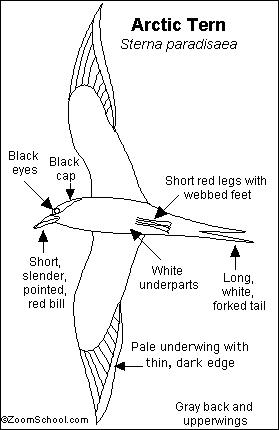
 |
| You might also like: | Cape Buffalo Printout | Narwhal Printout Unlabeled | Snow Goose Printout | American Golden Plover Printout | Minke Whale Print-out | Today's featured page: Volcano Diagram Printout |
| All About Birds | EnchantedLearning.com Arctic Tern | Animal Printouts Label Me! Printouts |


These social birds live in large groups, called colonies. Immediately before beginning a migration, a noisy colony of birds suddenly becomes quiet, and they all take to the air and fly away (this behavior is called "dread").
Arctic terns have a life span of about 20 years.
Anatomy: The Arctic tern is about 12 to 15 inches (30-38 cm) long and weighs about 2.8-4 ounces (80-110 grams). Males and females are similar. The Arctic tern has webbed feet, the tail is long and forked, the legs are short and red, and the head is rounded and white with a black cap.
Diet: The Arctic tern eats mostly small fish, and to a lesser degree, small invertebrates, like insects, shrimp, and krill. The tern swoops down into the water to catch its prey.
Eggs and Nests: In Arctic breeding grounds, females lay 1-2 cream-colored eggs with brown speckled eggs (1.6 inches long) in each clutch (a set of eggs laid at one time). The eggs are laid in a grassy area. Both parents care for the eggs and feed the hatchlings.
| Search the Enchanted Learning website for: |